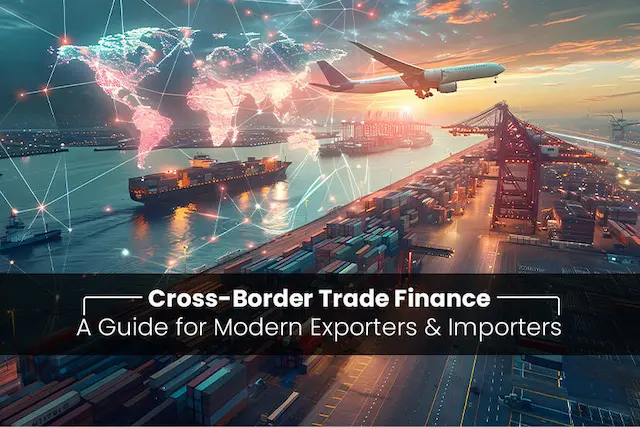Export financing is a pivotal driver of international trade, providing essential financial tools to businesses engaged in cross-border transactions. By offering working capital support, export financing empowers exporters to cover production costs, packaging, and transportation, ensuring they can meet the financial demands of the export process.
Importantly, it plays a key role in risk mitigation, offering protection against currency fluctuations, political instability, and non-payment risks. This risk management aspect boosts exporter confidence, encouraging them to explore new markets and expand their global presence. Additionally, export financing fosters market access by providing businesses with the capital needed to enter new territories, tap into emerging opportunities, and ultimately contribute to the growth of global trade.
The availability of diverse financing options, such as pre-export financing, export credit insurance, and government-backed programs, underscores the multifaceted support that export financing provides to facilitate and promote international trade.
What is Export Financing?

Export financing refers to the various financial instruments and mechanisms designed to facilitate and support international trade by providing the necessary funds to exporters. It involves the provision of working capital to cover the costs associated with producing and selling goods or services to buyers in other countries.
Export financing helps businesses manage the risks and cash flow challenges associated with cross-border transactions.
Common forms of export financing include pre-export financing, working capital loans, export credit insurance, letters of credit, and government-backed export financing programs. These financial tools play a crucial role in enabling businesses to expand their global reach, fulfill international orders, and navigate the complexities of the export process.
What is the Process of Export Financing?
The process of export financing involves several steps to ensure that exporters have the necessary funds to support their international trade transactions. Here is a general overview of the export financing process:
Assessment of Export Order: Exporters begin by evaluating the terms and conditions of the export order. This includes understanding the cost of production, transportation, and other associated expenses.
Identification of Financing Needs: Exporters identify their financial requirements for fulfilling the export order. This involves determining the amount of funding needed to cover production costs, packaging, transportation, and any other expenses related to the export transaction.
Selection of Financing Option: Based on their needs and preferences, exporters choose the most suitable export financing option. Common options include pre-export financing, working capital loans, letters of credit, export credit insurance, and government-backed export financing programs.
Application for Financing: Exporters submit an application for financing to the chosen financial institution or lender. The application typically includes details about the export order, the amount of financing required, terms of payment, and other relevant information.
Credit Assessment: The financial institution assesses the creditworthiness of the exporter. This involves reviewing the exporter’s financial history, business reputation, and the specifics of the export transaction.
Approval of Financing: If the credit assessment is favorable, the financial institution approves the export financing. The terms and conditions of the financing agreement, including interest rates, repayment terms, and any collateral requirements, are outlined.
Documentation and Compliance: Exporters complete the necessary documentation to comply with the financing agreement. This may include providing details about the export contract, invoices, shipping documents, and any other information required by the financing institution.
Disbursement of Funds: Once all requirements are met, the financial institution disburses the funds to the exporter. These funds are then used to cover the various costs associated with the export transaction.
Execution of Export Order: With the received funds, exporters can proceed with the production, packaging, and transportation of the goods or services. The export order is fulfilled in accordance with the terms agreed upon.
Repayment of Financing: Exporters repay the financing according to the agreed-upon terms. This may involve making periodic payments or settling the entire amount upon receiving payment from the foreign buyer.
Monitoring and Reporting: Throughout the process, both the exporter and the financing institution monitor the progress of the export transaction. Reporting mechanisms may be in place to keep all parties informed about the status of the financing arrangement.
Export Financing Options For Trade
Let’s explore some ways businesses can get financial help when selling things to other countries:
Getting Ready to Ship Finance: This type of help gives money to businesses before they send products to customers in different countries. It helps them prepare and send goods, manage money, and compete globally.
After Sending Goods Finance: This helps businesses after they’ve sent products to customers. It bridges the time between sending the goods and getting paid, making sure businesses have money to cover their costs.
Secure Payment Letters: These are documents from a bank that promise to pay the seller a certain amount under specific conditions. It ensures that both the seller and the buyer are secure in their payment dealings.
Insurance for Export Credits: This powerful tool protects businesses from risks like not getting paid. When selling things internationally, businesses might worry about the buyer’s ability to pay or political issues in the buyer’s country. Export credit insurance helps by guaranteeing payment, even if the buyer can’t pay.
Factoring for Exports: In this option, a business sells its unpaid bills to a company at a lower price to get immediate cash. It’s useful when dealing with customers who buy on credit because it helps businesses get money faster.
Loans for Exporting: These loans are made to help businesses involved in international trade. They can be used for different things, like managing money, buying goods, or growing the business. Banks and financial groups usually offer these loans.
Working Money Programs for Exports: Some governments and global organizations offer programs to help businesses with their day-to-day money needs when going global. These programs provide access to money at good terms, aiming to make a country’s goods more competitive and boost economic growth.
Export Financing Helping Trade
Export financing serves as a catalyst for international trade in several ways, fostering economic growth and global business interactions.
Risk Mitigation: Risk mitigation is paramount in international trade, and export financing instruments play a pivotal role in safeguarding businesses. In addition to export credit insurance and letters of credit, these tools help manage uncertainties related to delivery delays, quality issues, and unforeseen changes in market conditions. By providing a financial safety net against non-payment, currency volatility, and geopolitical challenges, these instruments foster confidence among businesses, empowering them to actively participate in cross-border transactions and explore new global markets.
Working Capital Support: By providing working capital, export financing ensures that businesses have the necessary funds to cover production, packaging, and shipping costs, enabling them to fulfill international orders.
Market Diversification: Export financing facilitates market diversification by supporting businesses in exploring new markets, reducing dependence on specific regions, and seizing opportunities in emerging economies.
Competitive Edge: Securing export financing not only provides a competitive edge but also amplifies a business’s market appeal. Beyond flexible payment terms, it enables companies to invest in innovation, enhance product quality, and expand marketing efforts. This financial support ensures a robust supply chain, timely deliveries, and improved customer relationships. With the ability to navigate global markets confidently, businesses gain a competitive advantage by showcasing reliability and adaptability, making them more attractive and trustworthy in the dynamic landscape of the global marketplace.
Promoting Small and Medium Enterprises (SMEs): Export financing is particularly beneficial for SMEs, offering them the financial means to participate in international trade, expand their reach, and compete with larger enterprises.
Boosting Innovation: Financial support encourages businesses to invest in innovation and technology, enhancing the quality and competitiveness of their products in the global market.
Infrastructure Development: Export financing contributes to infrastructure development, ensuring efficient transportation and logistics networks that are vital for the smooth flow of goods in international trade.
Trade Finance Instruments: Export financing encompasses various instruments, including letters of credit and bank guarantees, which facilitate secure and standardized trade transactions, reducing transaction risks for all parties involved.
Government Support: Many countries provide government-backed export financing programs, encouraging businesses to explore international markets and promoting national economic interests.
Enhancing Global Connectivity: Export financing strengthens global economic ties by facilitating smoother financial transactions and fostering cooperation between businesses across borders.
Adherence to Quality Standards: Access to financing encourages businesses to invest in meeting and exceeding international quality standards, enhancing the global reputation of their products.
Economic Stability: By promoting international trade, export financing contributes to economic stability by diversifying revenue sources and reducing dependence on domestic markets.
Sustainable Growth: Export financing supports sustainable growth by providing businesses with the financial means to invest in environmentally friendly practices and align with global sustainability standards, addressing the growing demand for eco-conscious products.
Extend Your Global Reach with Credlix
Credlix excels in facilitating international transactions, specifically focusing on open account sales, letters of credit, and documentary collections. Our solution addresses immediate cash flow challenges by acquiring your company’s accounts receivable, providing an advance of up to 95% of the total invoice value. With Credlix, you can seamlessly navigate cross-border transactions, ensuring a smooth and efficient process for your global business expansion.
Final Words
Export financing is like a passport for businesses to thrive globally. It provides the financial fuel needed for companies to confidently venture into international trade, manage risks, and compete on a world stage. From securing payments to fostering innovation and supporting sustainable practices, export financing opens doors for businesses, both big and small.
With partners like Credlix, extending your reach across borders becomes not just a possibility but a streamlined reality, empowering your business to flourish in the vast landscape of international commerce. Cheers to a world of opportunities and seamless global expansion!




